
15 minute read
The Effect of Thickener on EP Additive Response
Gaston A. Aguilar; Joseph P. Kaperick, Michael Lennon and Grant Pollard
Afton Chemical Corporation 500 Spring Street • Richmond, Virginia 23219
Abstract
It is recognized in the industry that thickener used in lubricating greases can interfere and negatively impact additive function. Extreme pressure and antiwear additives that function at the interface of the lubricant and mating surfaces are particularly affected. This study measured the effect of thickener concentration on load-carrying ability of lithium complex grease system. Specifically, Timken EP tests were conducted on grease formulation at three consistencies treated with a constant amount of a sulfur-phosphorus (S-P) gear oil additive package. The testing showed that Timken OK loads were not affected by soap thickener concentration. Timken EP tests were also performed on corresponding base oil formulation over a range of passing loads that encompassed the highest passing load and ensuing failure load of the greases. The effect of the thickener was demonstrated by comparing differences in test temperatures, wear scar widths and tribo-film coverage and composition. Another objective of this study was to elucidate mechanism by which thickener interferes with S-P additive system. For this effort, oil separation experiments were conducted and the resulting oils were analyzed to measure decreases in additive concentration. These experiments showed that sulfur concentrations in the grease bleed oils were not significantly different than the formulated oil. On the other hand, phosphorus was not detected in the separated oil indicating that phosphorus antiwear additives were completely retain in the bulk of the grease, probably due strong interaction with soap thickener. These results correlated well and helped explain differences in test temperatures, wear scar widths and tribo-film compositions observed between the greases and the corresponding base oil formulation.
Introduction
Greases are typically described as lubricating compositions composed of base oil and additives entrapped in a network of solid thickener particles, platelets, clumps and/or fibers. Thus, the physical and chemical interactions of thickener with additives are recognized by many in the industry as having a significant effect on additive performance1-2. However, there are few published studies that have detected these interactions and/or measured the effect of these interactions on lubrication performance. This does not imply that grease lubrication, specifically of rolling bearing, has not been studied. Numerous models have been published to explain the mechanism by which grease lubricate roller bearings in elastohydrodynamic lubrication (EHL) regime. For the most part, bleeding, which is the separation of base fluid, additives and/or thickener from the bulk grease is recognized as an important factor in these models2-3. In one such study, Cousseau and co-workers used a ball-on disc test rig and optical interferometry to measure the film thickness produced by different formulated greases, their bleeds and base oils. They found film thickness of grease resembled that of their bleeds more than their base oils. This observation underscores the importance of understanding how thickener-additive interaction and surface competition effect load-carrying ability of greases.
In one study focused on thickener-additive interactions, Sivik and co-workers utilized phosphorus Nuclear Resonance Spectroscopy (31P NMR) to analyze the interaction of zinc dithiophosphate (ZDDP) with lithium 12-hydroxystearate grease4. Their analysis revealed that ZDDP underwent chemical changes in grease containing residue amounts of lithium hydroxide raw material. The changes involved the formation of lithium dithiophosphate along with a decrease in neutral ZDDP and an increase in basic ZDDP levels. Sivik proposed a mechanism in which neutral ZDDP reacts with lithium hydroxide to form lithium dithiophosphate, zinc oxide and water. The resulting ZnO then reacts with neutral ZDDP to produce additional basic ZDDP. More pertinent to effect of these interactions was the analysis of the basic lithium 12-hydroxystearate grease after “exhaustive” hexane washing. The result of 13P NMR study showed that a significant amount of neutral ZDDP was retained in grease, which Sivik and co-workers proposed was due to polar-polar “association” of the ZDDP with the lithium soap fibers.
In another study, Kaperick used Timken test methods to compare the load-carrying capacity of a sulfurphosphorus gear oil additive package treated into lithium complex grease and the corresponding base oil formulation5. Since the rate of lubricant delivery for the grease and oil test methods are different, Kaperick first adjusted the delivery systems to investigate the effect of lubricant delivery rates. It was found that differences in delivery rate of the lubricant did not affect Timken response. The major finding was a large decrease in Timken response for the S-P gear oil package in the grease formulation. It was concluded that decrease response was due to thickener-additive interactions that reduced the ability of additives to get to the mating surfaces or interfered with additive function.
This paper is an extension of the Kaperick’s work. Specifically, the Timken test methods were again used to compare the response of an S-P additive package in lithium complex grease and the corresponding base oil formulation. The study was broadened to include different grease consistency grades to determine if additive response was affected by thickener/base oil concentration. The thought was that softer grease formulations containing less thickener would behave more like the base oil formulation. The study also incorporated an extended test protocol to further demonstrate differences in the lubricating mechanism of grease versus its corresponding base oil formulation. These measurements and techniques are briefly described below:
• Temperature readings were taken to measure rate and extent of temperature increase generated by frictional forces during Timken runs. • Wear widths on test blocks were measured on some partial grease Timken runs and all complete Timken runs. • Scanning Electron Microscope-Energy-Dispersive
X-Ray Spectroscopy (SEM-EDX) was used to get a measure of tribo-film coverage and composition. • Oil separation experiments were performed on greases to compare additive content of bleed oils against base oil formulation.
The investigation showed that grease consistency did not affect the load-carrying capacity. All grease consistencies were judged to pass the Timken test at a 40 lb. load and to fail at a 50 lb. load due to metal pulling or scoring after complete 10 minute runs. As expected, the base oil formulation passed the Timken test at 30, 40, 50 and 60 lb. loads. Additional measurements showed that the base oil formulation at all test loads had rapid rates of temperature increase that plateau at approximately 2 minutes and produced relatively constant wear scar widths covered with tribo-films rich in phosphorus content. On the other hand, grease formulations had much slower rates temperature increase, generated wider wear widths that increased with test time and produced sparser tribo-films rich in sulfur content and containing none detectable to trace amounts of phosphorus. These results are consistent with oil separation experiments that revealed that phosphorus components in additive package were unable to bleed away from greases regardless of consistency while sulfur levels matched that of the oil
formulation.
Experimental Timken Testing
Tests were carried out using “Standard Test Method for Measurement of Extreme-Pressure Properties of Lubricating Fluids (Timken Method)”, ASTM D-2782 and “Standard Test Method for Measurement of LoadCarrying Capacity of Lubricating Grease (Timken Method)”, ASTM D 2509 on oil and greases respectively. Both Timken test methods consist of passing lubricant through an interface that consists of steel cup rotating against steel block at a static spindle speed of 800 ± 5 rpm and static load for a 10 minute test period. For each test, loads are increased until film rupture is detected by either excessive wear or scoring on the test block. For this study, temperature readings were collected at one minute intervals using Control Company Traceable® infrared thermometer gun. Temperature readings were taken on test cups at approximately 180 degree position from ring on block contact. Wear scar widths were measured using low power microscope (4X) with filar micrometer to measure with accuracy of ±0.05 mm (±0.002 in.). Contact pressures were calculated using measured scar widths on blocks and the equation provided in ASTM D 2509.
Surface Analysis
Test block surfaces were analyzed FEI Quanta 650 Scanning Electron Microscope (SEM) and Oxford Instruments X-Max 150 Energy-Dispersive X-Ray (EDX) detector. Analyses were performed on the same 4 mm by 3.5 mm area of each block containing part of the wear scar. The beam energy was kept at 5 kV to increase surface sensitivity. AZtec Version 2.2 software by Oxford Instruments was used to create images of the mapped area that consisted of three phases: 1) block background, 2) tribo-film and 3) carbon deposits. The AZtec software was also used to perform elemental quants of EDX spectra.
Blocks were clean before putting them in the SEM by the following procedure: 1) Heptane rinse 2) Wiping with heptane-soaked Kim wipes 3) Heptane rinse 4) Isopropyl alcohol rinse 5) Wiping with isopropyl alcohol-soaked Kim wipes 6) Isopropyl alcohol rinse 7) Nitrogen blow dry

Oil Separation Experiments
Greases were subjected to a modified IP 121 standard test method. In the standard method, grease is placed in a 240 mesh woven wire cloth cone and loaded with 100 gram weight. The cone is placed on stainless steel cup and bleed is collected for 168 hours at 40 °C. For this study, the collection period was decreased to 8 hours and collection temperature was increased to 140 °C. The 140 °C temperature was selected based on maximum temperatures measured during Timken tests. The test time was decreased to eliminate any oxidation effects. Collected bleed samples were analyzed for phosphorus and sulfur content. Phosphorus content was measured by inductively coupled plasma atomic emission spectroscopy (ICP) using a modified version of ASTM D 4951 standard test method. Sulfur content was measured using LECO Corporation SC-432 analyzer following ASTM D 1552 standard test method.
Lubricant Compositions
All lubricant compositions, oil and greases, were based on ISO 220 mineral oil blend and were formulated with 3 mass percent of a proprietary gear oil package consisting of sulfur based extreme pressure agents and phosphorus based antiwear additives. The grease formulations were made using unadditized, lithium complex base grease with penetration (60 x worked) of 185 m-1. All compositions were blended with standard laboratory equipment with mild heating (60 ± 5 °C) for time judged sufficient to thoroughly incorporate the additive package and achieve homogeneous mixtures (1-2 hours). A summary of lubricant compositions are provided in Table 1.
Table 1: Lubricant Compositions:

Results and Discussion
As summarized by Figure 1, Timken testing of the oil formulation showed no significant loss of load-carrying capacity of over a range of loads (30, 40, 50, and 60 lb.). All wears scars showed no visible signs of scoring and wear scar widths were narrow and did not change significantly with load. Average scar width for the four loads was 1.04 mm with a range 0.14 mm. The grease formulations were able to carry 40 lb. without scoring but wear widths were significantly larger than the oil formulation with average and range of 1.45 mm and 0.26 mm respectively. Not unexpectedly, the greases were unable carry 50 lb. load without scoring of the Timken blocks and wear widths jumped to average of 2.21 mm with a range of 0.39 mm.
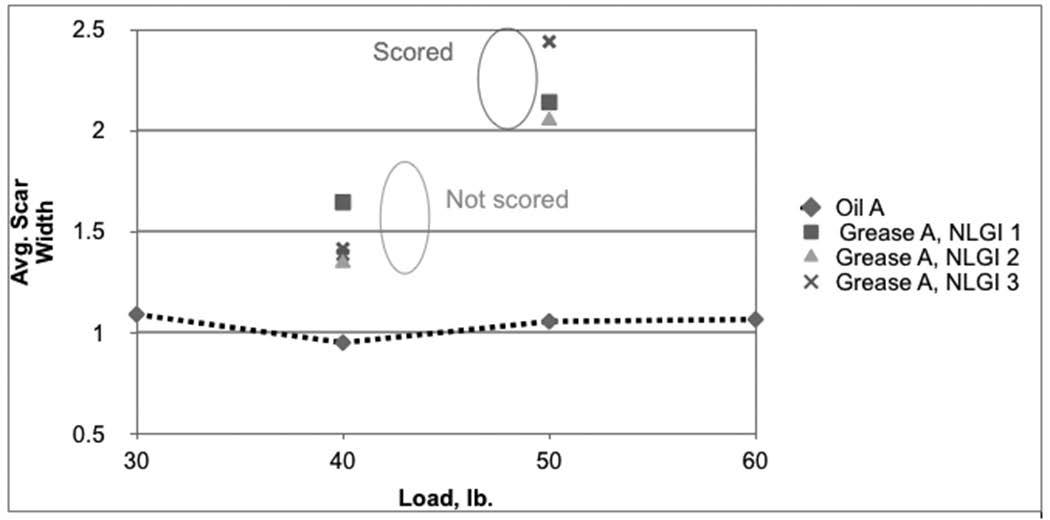
Figure 1: Graph showing poorer anti-scoring and antiwear performance of the S-P package in grease. Data points are an average two widths per scar.
Wear rates were investigated by stopping Timken tests at 3 and 4.75 minutes for the NLGI 1 and 3 greases at 50 lb. test load. As per Figure 2, wear scar widths increased with test time and were equal or exceeded the widths of oil formulation at 3 minutes. Interestingly, the thickener concentration did not appear to significantly affect test results. In other words, no improvement in performance was apparent with the softer more oil like grease.
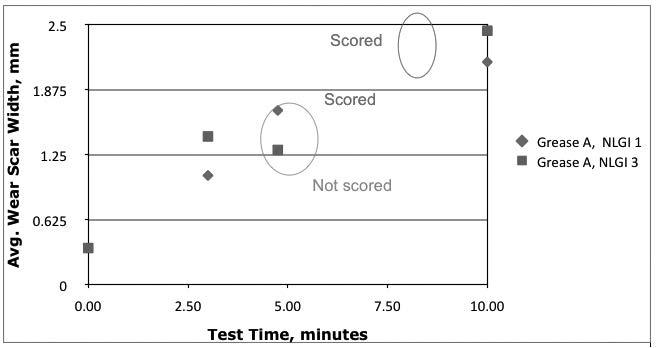
Figure 2: Graph showing wear increase of grease formulation with time. Data points are an average two widths per scar.
As summarized Table 2, surface analysis of block wear scars revealed that tribo-film compositions for grease formulations are indeed very different than the oil formulations. The oil formulation at all four loads produced tribo-films high on phosphorus and oxygen content, likely signifying the presence of phosphate films that are known to provide excellent antiwear protection6. Greases regardless of test load produced films with undetectable to trace amounts of phosphorus but four times more sulfur than the corresponding oil formulation, possibly signifying the presence iron sulfide and/or sulfate tribo-films generally generated by sulfur EP agents7. As per mapped tribo-film area data in Table 2, the sulfur rich films generated by the greases increased in area coverage with increasing grease consistency. This observation is opposite the idea that softer more oil like grease would perform more like oil counterpart. A more important observation is that the greases were unable to generate uniform tribo-film coverage at the higher 50 lb. load. SEM-EDX images in Table 3 visually depict this data.
The SEM-EDX data correlates well with wear scar width data. Both data sets suggest that thickener is interfering with phosphorus components and that load-carrying capacity for grease formulations is mostly attributed to sulfur EP additives, which function by producing sacrificial tribo-films that shear away to smooth mating surfaces and prevent metal-metal adhesion. However, sulfur EP compounds that are designed for lubricant applications typically function at high loads and temperatures. Examination of temperature data (Figures 3 and 4) reveals that grease formulations produced very different temperature profiles than the oil formulation.
Table 3: SEM-EDX Images of Timken Blocks for Grease Formulations and 10 minute Runs
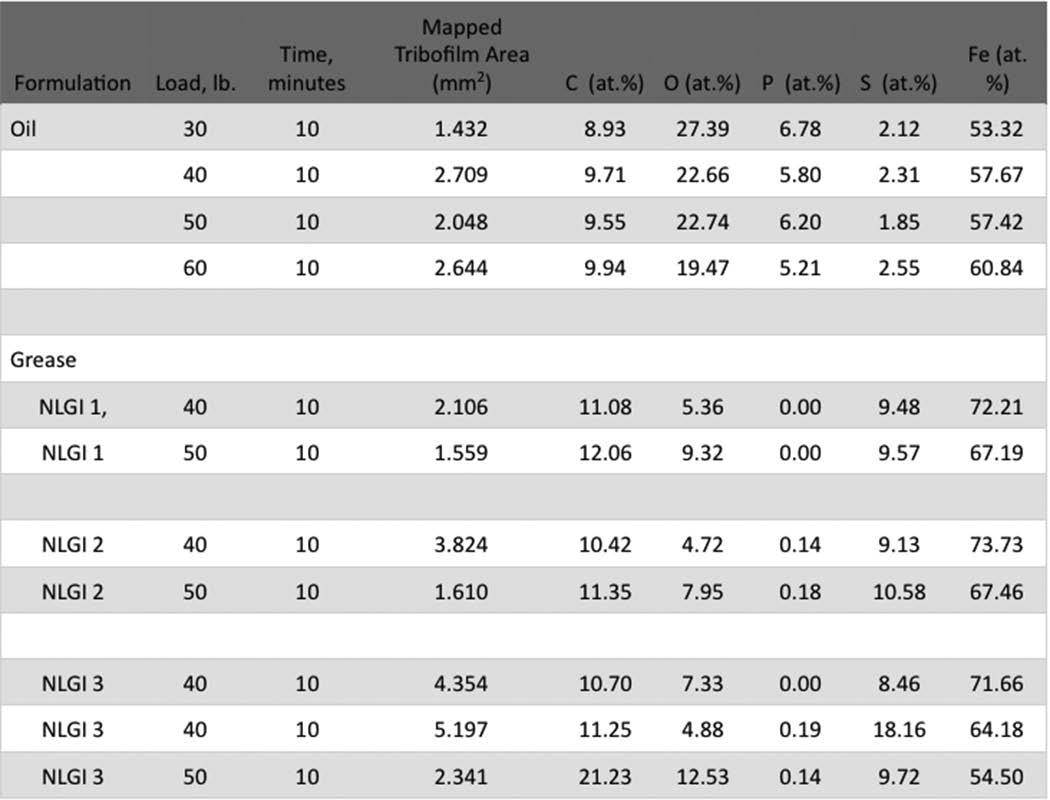

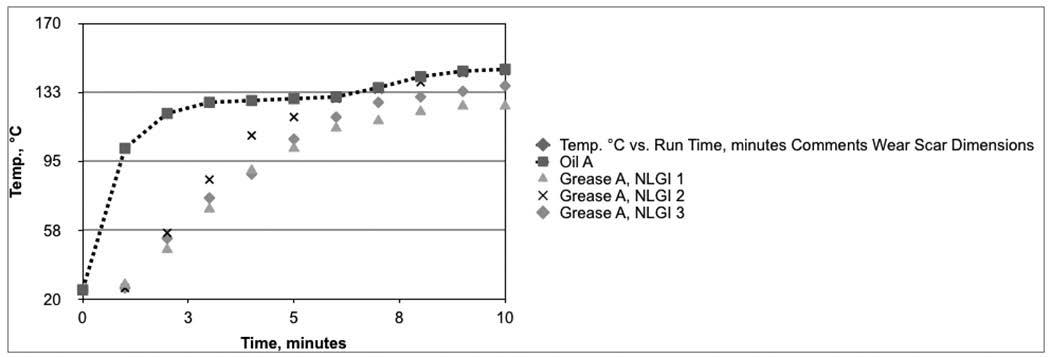
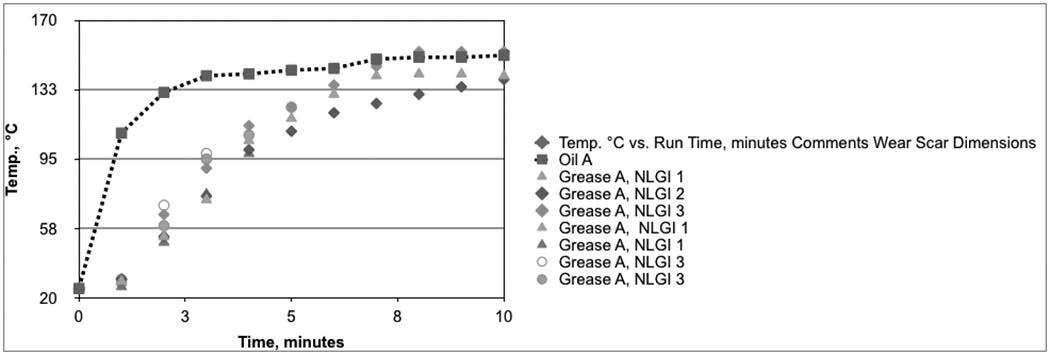
The oil formulation at all loads produced rapid rates of temperature increase that plateau quickly at approximately 2 minutes. On the other hand, grease formulations produced much slower and linear rates of temperature increase that start to plateau at approximately 6 minutes. As per Figure 5, the test temperatures for the oil formulation were proportional to contact pressures. In this case, contact pressures were solely dependent on load since wear areas remained constant at all test loads. This relationship is indicative of steady and uniform tribo-films at the mating surfaces. Conversely, contact wear areas for the grease formulations were not steady and increased with time (Figure 2). The wider scars led to reduction in contact pressures that explained the slower rates of temperature increase generated by the grease formulations but they are also indicative of thin and un-uniform film formation. As per Figure 5, the test temperature for grease formulations tested at the 50 lb. load were inversely proportional indicating temperature increase is partly due was to friction produced by metal to metal contact.
This assumption is supported by SEM-EDX examination of Timken blocks for partial Timken tests as shown in Table 4 and Table 5. The tribo-film images for 3 minute tests show almost no tribo-film formation but the wear scars had no visible scoring. These observations indicate that the thickener participated in carrying the test load.
For the 4.75 minute tests, tribo-film coverage increased slightly for the NLGI 1 grease and significantly for NLGI 3 grease. Sulfur contents of the films were higher for 4.75 minute test than 10 minute test. Nonetheless, the soap thickener appears to block the sulfur EP compounds from the surface, which with time and pressure lead to unsustainable tribo-films as is the case for 50 lb. 10 minute tests. A better understanding of how soap lubricates and interferes with sulfur EP additive could be gained by performing this study’s test protocol on oil formulation lacking phosphorus components and by running rheology and tribology tests with optical interferometry on grease bleeds following similar test methodology as Cousseau and co-workers.
Figure 5 Plots showing contact pressure and temperature relationship at end of test (10 minutes).
Table 4: SEM-EDX Data for Partial Timken Runs


Table 5: SEM-EDX Image for Grease Formulation at 50 lb. Test Load
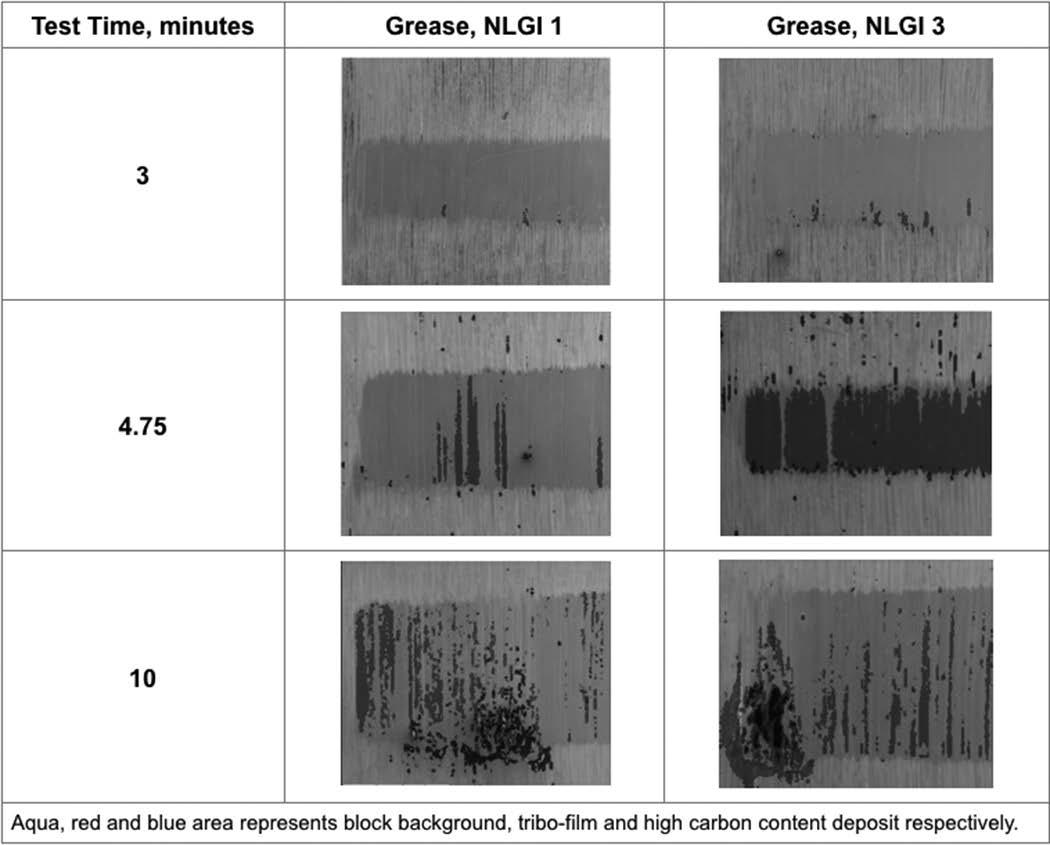
In regards to lack of phosphorus content in grease tribo-films, oil separation experiments were especially insightful. As per Table 6, bleed oil that separated from greases contained equal amount of sulfur content as the oil formulation but no detectable amount of phosphorus. Thus, it is concluded that a strong interactions with soap thickener inhibited phosphorus compounds from adhering and reacting metal surfaces.
To conclude, the study demonstrated that lithium soap thickeners can inhibit the function of EP and antiwear additives. Two basic mechanisms were proposed based on experimental observations. One mechanism involves soap blocking additives from metal surfaces as was the case with sulfur EP additives of this study. The second mechanism involves chemical interactions between the soap and additives that prevent the additives from adhering and reacting with metal surfaces. This mechanism would be more in effect with polar and ionic additives such as phosphorus compounds that are commonly used in gear oil additive packages.
Table 6: Phosphorus and Sulfur Contents for Oil Formulation and Grease Bleed Collected at 140 °C for 8 h.
References

Canter, N. Grease additives: Important contributors not be overlooked. Tribology & Lubrication Technology, December 2013, 28-29.
Lugt, P.M., Grease Lubrication in Rolling Bearing. John Wiley & Sons; 2013.
Cousseau, T., Björling, M., Graca, B., Campos, A., Larsson, R. Film thickness in a ball-on-disc contact lubricated with greases, bleed oils and base oils. Tribology International 2012; 53: 53-60.
Sivik, M.R., Zeitz, J.B., Bayus, D., Interactions of Zinc Dithiophosphates with Lithium 12-Hydroxystearate Grease. Presented at the Annual Meeting of the NLGI, at West Palm Beach Buena, Florida, (2001).
Kaperick, J., Timken OK Load – Media Bias? A Comparison of Timken Response to Similar Additive Systems in Both Grease and Oil Formulation. Presented at the Annual Meeting of the NLGI, at Lake Buena Vista, Florida, (2006).
Phillips, W.D., Ashless Phosphorus-Containing Lubricating Additives in Lubricant Additives: Chemistry and Applications, Second Edition, CRC Press,Rudnick, L.R. ed. (2009).
Bovington, C.H., Friction, wear and role of additives in their control in Chemistry and Technology of Lubricants, 3rd Edition, Springer, Mortier, R.M., Fox, M.F, Orszulik, S. T. ed. (2010).





